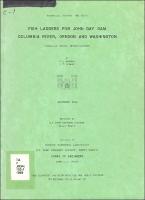Please use this identifier to cite or link to this item:
https://hdl.handle.net/11681/44282Full metadata record
| DC Field | Value | Language |
|---|---|---|
| dc.contributor.author | Johnson, Richard L. | - |
| dc.contributor.author | Perkins, Louis Z. | - |
| dc.creator | United States. Army. Corps of Engineers. North Pacific Division | - |
| dc.date.accessioned | 2022-05-16T15:28:28Z | - |
| dc.date.available | 2022-05-16T15:28:28Z | - |
| dc.date.issued | 1968-10 | - |
| dc.identifier.uri | https://hdl.handle.net/11681/44282 | - |
| dc.description | Technical Report | en_US |
| dc.description.abstract | Facilities for passing fish upstream over John Day Dam include a powerhouse collection system, fishway entrances at each end of the powerhouse, and a 24-ft-wide fish ladder on both sides of the river. The regulating sections and typical pools of the fish ladders are similar. Attraction and transportation flows are pumped from tailwater. The north fish ladder (except entrance section) and a portion of ladder adjacent to the south shore fish counting station were studied in a 1:10-scale model. A group of four typical diffusion chambers in each ladder was reproduced in a 1:8-scale model. Fishway weirs with 6-ft-long overflow crests at each end of a 12-ft-long nonoverflow section, upstream fins, and three 18- by 18-in. orifices at the floor were adopted. It is planned that the center orifice usually will be covered by removable plates. Orifice sizes in the regulating section were adjusted to control discharges and head drops between 19 nonoverflow bulkheads for an 11-ft range in forebay levels. Sloping floors, baffle beams at a constant elevation, and metering orifices 10-1/8 in. wide were selected to provide 60 cfs each for diffusion chambers 3 to 15 in the north fish ladder. These diffusers will operate with a head of 2 ft on the water-supply conduit at weir 155. Orifices 8 in. wide will furnish 60 cfs each in diffusers 4 to 16 of the south fishway. The conduit-to-tailwater differential is 3 it in this ladder. Improved designs were developed for weir 248 and bulkhead 249, which are adjacent to the north fish counting station. The addition of a third orifice in bulkheads 250 to 267 to assist passage of shad and sockeye salmon increased turbulence over the horizontal counting board in the north fish ladder. None of the floating devices that were studied in attempts to obtain smooth flow across the counting board was acceptable. The south fish counting station, with an illuminated vertical counting board, was satisfactory after the orifices in weir 193 were enlarged to reduce head on this weir. | en_US |
| dc.description.sponsorship | United States. Army. Corps of Engineers. | en_US |
| dc.format.extent | 110 pages / 25.15 MB | - |
| dc.format.medium | PDF/A | - |
| dc.language.iso | en_US | en_US |
| dc.publisher | United States. Army. Corps of Engineers. Walla Walla District. | en_US |
| dc.rights | Approved for Public Release; Distribution is Unlimited | - |
| dc.source | This Digital Resource was created from scans of the Print Resource | - |
| dc.subject | Fishways | en_US |
| dc.subject | Hydraulic models | en_US |
| dc.subject | Columbia River | en_US |
| dc.subject | John Day Dam (Or. and Wash.) | en_US |
| dc.title | Fish Ladders for John Day Dam, Columbia River, Oregon and Washington : Hydraulic Model Investigations | en_US |
| dc.type | Report | en_US |
| Appears in Collections: | Technical Reports | |
Files in This Item:
| File | Description | Size | Format | |
|---|---|---|---|---|
| Fish Ladders - John Day Dam - Hydraulic Model Investigation_1968.pdf | 25.15 MB | Adobe PDF |  View/Open |